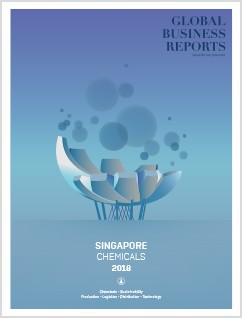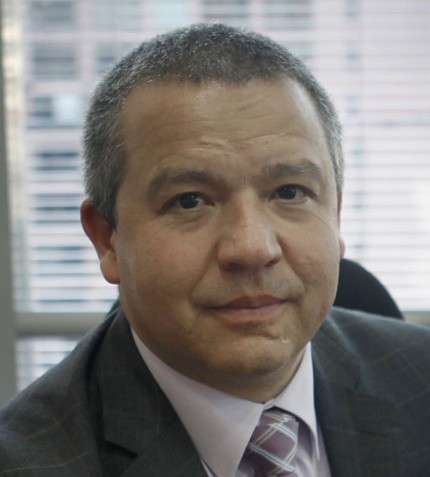
"The Government is committed to continue growing and attracting investments in the energy and chemicals industry. These investments need to fit the resource profile of Singapore and also be sustainable from an environmental perspective. Innovation remains a critical part of our past, present and future and, despite still being at the early stages of digitalization, we are impressed by the developments seen so far." - Cindy Koh
RELATED PUBLICATION
ARTICLES FROM THIS PUBLICATION
- Singapore’s Chemicals Sector is Undergoing a Transformation
- For a Rainy Day: Singapore targets water self-sufficiency
- Manpower Constraints a Persistent Burden for Industry in Singapore
- Singapore’s Chemical Producers: Feeding Asia’s Appetite
- Distribution: Streamlining the Channels
- The Brave New World of Chemicals
- Prosperity or Penury – Singapore's Petrochemicals Industry Faces Challenges to Re-invent Itself
Damian Chan & Cindy Koh
EXECUTIVE DIRECTOR, ENERGY & CHEMICALS AND DIRECTOR, ENERGY & CHEMICALS
Singapore was recently ranked 2nd as a driver of production in the World Economic Forum’s 2018 Readiness for the Future of Production Report. What sets Singapore apart as the preferred destination for the chemicals value chain?
DC: Singapore has a very well-established foundation for its energy and chemicals industry. The industry was built on its refineries and, during the 1980s, we integrated downstream into petrochemicals. The opening of Jurong Island in 2000 put Singapore on the path towards building a highly-integrated energy and chemicals complex, providing the city-state with a significant head start in the region. As a result, we now have over 100 energy and chemicals companies on Jurong Island. That provides Singapore with competitive advantage over other chemical hubs in the region, which are generally dominated by individual companies. For businesses looking to operate in Singapore, the opportunity to source for feedstock and then sell their products over the fence, is immense.
Moreover, our industry is export-oriented and driven by global demand and business cycles. As such, Singapore is highly reliant on global trade. Companies in Singapore will be able to tap into our extremely wide network of free-trade agreements, representing 60% of global GDP, which includes ASEAN, China, India and the United States. We are also in the process of ratifying the Singapore-EU trade agreement. Finally, given that investments in the industry are capital-intensive, predictability in terms of politics and government policy is essential and something we are able to provide.
CK: In addition, as Singapore moves towards higher value-added derivatives, intellectual property (IP) protection with respect to innovation and manufacturing processes will be very important. For many companies, formulation and process technologies are trade secrets, so they appreciate Singapore’s respect for IP protection.
The carbon tax has been a major topic amongst Singapore’s manufacturers. What do you hope the 2019 carbon tax will achieve?
DC: The carbon tax will be levied on large emitters that emit 25,000 tons and above of greenhouse gas annually. It will be priced at a flat rate of S$5 per ton for a transition period of five years from 2019 to 2023. The first payment will be made in 2020, based on emissions in 2019. While the current longer term intent is to raise the carbon tax to S$10-S$15 per ton of emission by 2030, changes to the carbon tax will take into account international climate change developments, the progress of Singapore’s emissions mitigation efforts, and economic competitiveness. The Government has factored competitiveness concerns, and that is why the starting rate is relatively low and is fixed for the first five years. In addition, the revenues collected will be used to support companies’ energy efficiency and carbon reduction projects.
The Singapore Government estimates that about S$1 billion will be collected from the carbon tax over the initial five years. However, the carbon tax is not a revenue generating exercise. The Singapore Government is prepared to make available more than what is collected to support worthwhile energy efficiency and carbon emissions reduction projects in industry. Many of the oil majors have announced their commitment to sustainability and we look forward to stronger collaboration so as to increase energy and emissions efficiency for the long term. We foresee that carbon pricing will become more pervasive moving forward and our early efforts will position Singapore well for the future, especially when carbon capture or sequestration technologies becomes more widely available.
Industry 4.0 technologies have become a key focus for Jurong Island with automated systems, driverless trucks and big data a few of the new technologies being implemented. How important will it be for the industry to embrace these technologies and how will they stand to benefit?
DC: We are heartened by the early adoption of these technologies by manufacturers. Additionally, there are a number of solutions providers that are opening digitalization hubs and centers of excellence in Singapore, including Accenture, Emerson, Yokogawa, Siemens and GE. Digital transformation ranks highly on the Singapore Government agenda because such technologies have a wide range of application. For instance, besides investing in cogeneration plants, digitalization could be a low-hanging fruit for companies wanting to improve energy management to reduce carbon emissions. Digitalization could also improve competitiveness by enhancing productivity in the areas of inspection and maintenance.
In addition, the Singapore Government, alongside TÜV SÜD, launched the Singapore Smart Industry Readiness Index (‘Index’) - a diagnostic tool that companies can use to evaluate their Industry 4.0 readiness and develop a transformation roadmap.
CK: With regards to digitalization, I believe it is also important to upskill existing employees to ensure they are future-ready. As part of Singapore’s efforts to ensure that the workforce is digitally confident, efforts have also been made to identify skills that vocational institutions and institutes of higher learning should prioritize for training.
The Energy and Chemicals Transformation Map (ITM) is aiming for a manufacturing value added (MVA) of S$12.7 billion as well as 1,400 new jobs by 2025. Can you introduce our readers to the ITM and tell us what it sets out to achieve?
DC: The initiative to develop roadmaps for 23 sectors originated from a recommendation by Singapore’s Committee on the Future Economy. Each ITM sets out a holistic roadmap for each industry across four main pillars of focus: productivity, innovation, skills and jobs, and trade and internationalization.
The ITM leverages Singapore’s tripartite approach – government, unions and industries – to work together on the future competitiveness and sustainability. The productivity segment outlines the priorities with respect to improving and upgrading the existing plants in Singapore, both in terms of digitalization and product upgrading. Key to this is the diversification from commoditized to higher value added and specialty-grade products.
The other part includes system-level solutions to help improve competitiveness. This involves providing increased opportunities for companies to carry out feedstock diversification, as well as investing in logistics. For example, Petrochemical Corporation of Singapore’s new naphtha storage tanks have enabled them to respond quicker to the changing needs of the market as they have flexibility to blend different grades of naphtha. Vopak’s new LPG terminal also provides crackers with an alternative feedstock beyond naphtha.
The jobs and skills segment is mainly tied to Singapore’s SkillsFuture initiative, which is a national movement that promotes lifelong learning and skills mastery. Alongside the ITM, we launched the SkillsFramework for Energy & Chemicals. It maps out, and makes available to the public, information related to career paths in the industry and the skillset required for each path. Subsequently the Government will ensure that there are relevant courses available for individuals that want to upgrade or upskill themselves.
A*STAR is trying to increase collaboration between research institutions and the industry. How important are Singapore’s research institutions in attracting new industry investment?
CK: Our work in this area is closely tied to the innovation pillar of the ITM. Specialty chemicals is the growth engine of Singapore’s energy and chemicals industry, and for these companies, the ability to formulate the right products and deliver customized solutions is a key differentiating value proposition.
In this regard, we have shortlisted five initial focus areas that have demonstrated strong growth potential in Asia: consumer chemicals, oilfield water chemicals, lubricant additives, animal health nutrition and agrochemicals.
We have also conducted a joint-road mapping exercise with A*STAR, where we identified four to six technology platforms and capabilities to invest in. Through this exercise, we realized that while the end markets may differ, the technologies we want to invest in could have applications in more than one market and so we are seeing increased collaboration across sectors.
Manpower constraints continue to burden companies across the value chain due to increased quotas on foreign workers and a local workforce lacking technical depth. What is the government doing to alleviate this burden?
CK: There is a concerted effort from the EDB to promote engineering as a vocation. Industry needs to employ individuals with a diverse background in engineering and science, such as chemistry, biology and material science.
DC: In terms of industry’s attractiveness to Singaporeans, this is a matter that we have continuously worked on. The Chemical Industry Manpower Advisory Committee (CHIMAC), that I co-chair, alongside the Singapore Chemicals Industry Council (SCIC), works on initiatives to engage universities, polytechnics and institutes of technical education to increase awareness of job opportunities and to dispel misconceptions about the industry such as safety and accessibility.
The industry remains attractive to Singaporeans. More than 70% of the employees in the industry are Singaporean, the highest of the manufacturing sectors, due to the career opportunities and remuneration.
What will be the major milestones for the chemicals sector moving forward?
DC: We expect to see a healthy amount of investment moving forward. Important milestones in 2019 will include the implementation of the carbon tax as we start supporting companies more aggressively in terms of energy efficiency. Moreover, we anticipate continued upgrading investments from the refineries and crackers. There is also potential for an additional cracker and downstream petrochemicals clusters on Jurong Island. We are fully committed to growing the sector sustainably and we are open to businesses wanting to invest in Singapore.
CK: The Government is committed to continue growing and attracting investments in the energy and chemicals industry. These investments need to fit the resource profile of Singapore and also be sustainable from an environmental perspective. Innovation remains a critical part of our past, present and future and, despite still being at the early stages of digitalization, we are impressed by the developments seen so far. For innovation, we hope to build R&D capabilities to reinforce our current manufacturing footprint activities. Moving forward, we want to expand further from the five end markets previously identified to advanced materials, such as additive manufacturing and composites.











